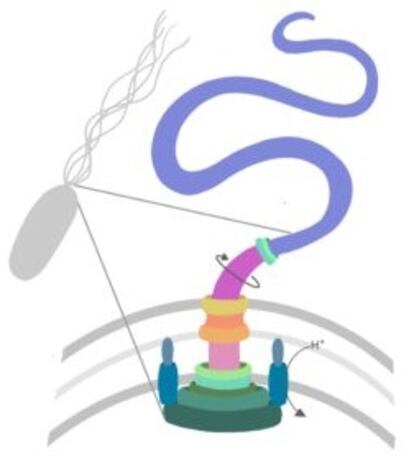a structure that makes them one of the fastest living beings in the world, since they can travel in a single second the space equivalent to 100 times their length.
As if a person of 1.70 meters moved at about 600 kilometers per hour.
There are about 10 times more bacterial cells in the human body than human cells.
In many cases they are harmless or even beneficial, such as those that are part of the microbiome of the digestive tract.
However, pathogens pose a growing threat.
Their ability to survive depends largely on their ability to move, a function they use to colonize spaces or flee from threats.
In this sense, Pulido-Sánchez explains: "Studying how bacteria behave and function is crucial to understanding the numerous fundamental processes for life in which they participate."
The Andalusian Center for Developmental Biology, a joint center of the UPO, the Higher Council for Scientific Research (CSIC) and the Andalusian Government, has spent more than a decade studying how bacteria form communities that generate, for example, dental plaque or a serious infection. One of the keys is its mobility, a vital function to colonize, defend or attack. And the key weapon of this is the flagellum, an elongated molecular complex made up of up to 30 different proteins, depending on the species, capable of propelling the bacterium at unique speeds and directing it to new spaces.
This realm of body-proportional speed is dominated by microscopic organisms.
The record, according to the University of Regensburg (Germany), is for the archaea, a unicellular organism capable of traveling a distance equivalent to 500 times its size in one second.
Simplified structure of a bacterial flagellum.UPO
The bacterial flagellum resembles helices. The biological motor is anchored to the cell wall and converts an electrical current (protons) into rotational movement. A system, like a switch, allows changing the direction of rotation by acting on an axis that connects the energy source with the filament, the protein appendage that protrudes from the cell and works like the blades of the propeller. Understanding this unique structure is essential, since eliminating or altering any of the parts that make up this "molecular machine" would allow the system's functions to be interrupted or take advantage of it, according to the Spanish microbiologist, to direct, for example, a drug to a certain place of the organism.
In this sense, Martin Schmeing, professor of biochemistry at McGill University (Canada) and author of a recent study on bacteria published in
Nature Chemical Biology
, highlights the importance of the bacterial energy engine: "Bacteria can store additional resources for times of lean cows. It's a bit like keeping a piggy bank or carrying a backup battery." The enzyme that produces these batteries has been investigated for water treatment and for the creation of heat-sensitive nanovesicles for use in targeted drug delivery.
For his part, Blas Vinagre, Professor of Electrical, Electronic and Automatic Engineering at the University of Extremadura, presented at Uned the opportunities to create swimming robots of the bacterial flagellum type for their applications in different fields, from medicine (diagnostic and therapeutic procedures less invasive) to industry (inspection tasks in infrastructures and machines).
The work that has revealed the machinery of the bacterial flagellum, directed by Fernando Govantes, a scientist in the Microbiology Area of the Pablo de Olavide University, has been published in the journal
Environmental Microbiology
.
The researcher explains that they have used
Pseudomonas putida
as a model organism , "a bacterium", as he states, "of great interest in environmental biotechnology and agriculture, since it is associated with the roots of plants and promotes their growth, while protects them from potential pathogens.
In this bacterium, the instructions for making the pieces of the flagellum are grouped together in the genome, as if they were a manual, according to the UPO and the CSIC. The model that the scientific community assumed until now was based on the fact that flagellar genes are expressed by well-defined groups in three or four sequential waves called cascade jumps. First, the proteins that give the order to the cell to start building the flagellum are expressed. These proteins are responsible for expressing the central core of the machine that is inserted into the cell wall. Later, others give the order to build the filament that extends out of the bacterium.
Govantes details: “However, with the strategy that we have continued to integrate the results of different analyses, we have discovered in
Pseudomonas putida
that the reality is much more complex: not only are there these jumps in the cascade, but we also find a second level of overlapping regulation: proteins that order the construction of the last pieces of the machine also order that more pieces of the initial ones be made. Also, when the instructions to make the filament are written, the instructions that cause the cell to start flagellum synthesis all over again are written at the same time.”
Pulido-Sanchez specifies: “The instructions overlap with each other;
that is, when the instructions are written to make the last components, the last pieces of the flagellum, the instructions to make the protein responsible for initiating synthesis are written at the same time”.
The meaning of this last mechanism, unknown until now, will be one of the research fields of the group.
You can follow
MATERIA
on
,
and
, or sign up here to receive
our weekly newsletter
.
Exclusive content for subscribers
read without limits
subscribe
I'm already a subscriber

